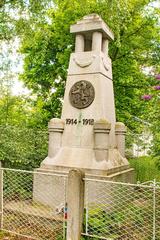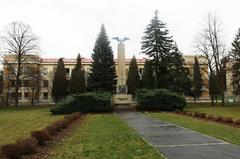Statue Of John Of Nepomuk In Bělobranské Náměstí
Visiting the Statue of John of Nepomuk in Bělobranské Náměstí, Pardubice: Complete Guide
Date: 03/07/2025
Introduction
The Statue of John of Nepomuk in Bělobranské Náměstí, Pardubice, is a profound symbol of Czech religious heritage, Baroque artistry, and local cultural identity. Honoring Saint John of Nepomuk (Jan Nepomucký)—a 14th-century priest revered for his martyrdom and the defense of the confessional seal—this monument stands as both spiritual guardian and historical landmark in Pardubice’s heart. Visitors are drawn to the statue’s intricate iconography, its central location among the city’s historic sites, and the living traditions that continue to surround it (private-prague-guide.com, wikiwand.com).
This guide delves into the statue’s history, artistic features, cultural relevance, and practical visitor information, empowering explorers and history enthusiasts to appreciate the enduring legacy of John of Nepomuk in Pardubice and beyond. For enhanced travel planning, guided audio tours are also available (Audiala app).
Table of Contents
- Introduction
- Saint John of Nepomuk: Historical Background
- The Spread of His Cult and Artistic Legacy
- The Statue in Bělobranské Náměstí: Art, Symbolism, and Local Context
- Visiting Information: Hours, Tickets, Accessibility
- Nearby Historical Sites
- Cultural Traditions and Etiquette
- Practical Tips for Visitors
- Frequently Asked Questions
- Conclusion
- Sources and Further Reading
Saint John of Nepomuk: Historical Background
Saint John of Nepomuk, born circa 1345 in Pomuk, Bohemia (now Nepomuk, Czech Republic), rose to prominence as vicar-general to the Archbishop of Prague. His life was marked by religious conflict during King Wenceslas IV’s reign. In 1393, John was executed—thrown from Prague’s Charles Bridge into the Vltava River—after refusing to betray the confessional secrets of Queen Sophia, according to popular legend (private-prague-guide.com; isharethese.com). While contemporary sources document a political dispute behind his death, the narrative of martyrdom for the sanctity of confession became central to his enduring legacy (catholicsaints.day).
The cult of John of Nepomuk grew rapidly, especially during the Counter-Reformation, as the Catholic Church sought to reinforce its influence in Bohemia (wikiwand.com). Canonized in 1729 by Pope Benedict XIII, John came to symbolize integrity, loyalty, and resistance to tyranny.
The Spread of His Cult and Artistic Legacy
The veneration of John of Nepomuk was institutionalized through widespread construction of churches, chapels, and statues across Central Europe. The earliest major statue was installed on Prague’s Charles Bridge in 1683, establishing a recognizable iconography: a priest in canonical attire, holding a crucifix, with a five-star halo—a reference to the legend that five stars appeared above the water where his body was found (artsandculture.google.com, boboandchichi.com).
By the 18th century, thousands of statues had been erected throughout Bohemia, Austria, and Germany, with significant numbers in Poland, Slovakia, Hungary, Spain, and beyond (wikiwand.com). Statues are commonly found on bridges or near water, reflecting John’s role as a protector against floods and a patron of bridges (relics.es). The motif of five stars, the crucifix, and, occasionally, a finger pressed to the lips (symbolizing discretion) are universal features.
The Statue in Bělobranské Náměstí: Art, Symbolism, and Local Context
Artistic Features and Iconography
The Pardubice statue is a classic Baroque religious sculpture, likely crafted from stone, depicting John of Nepomuk in priestly robes, holding a crucifix, and crowned by the five-star halo (artsandculture.google.com). Palm branches (martyrdom) and other decorative elements may also be present. The expressive, dynamic posture and intricate drapery are hallmarks of the Baroque style, inviting viewers to contemplate sacrifice, faith, and moral steadfastness.
Placement and Urban Significance
Located in Bělobranské Náměstí (White Gate Square), the statue is set amidst flowerbeds and mature trees, surrounded by other historical buildings and features (tourismato.cz). Its presence in a central, accessible public space underscores the saint’s role as a community guardian and a symbol of collective identity.
Heritage Status
The statue is a protected cultural monument, entered into the state register before 1988, ensuring preservation and regular maintenance (cs.wikipedia.org).
Visiting Information: Hours, Tickets, Accessibility
- Visiting Hours: Open 24/7. As an outdoor public monument, the statue is accessible year-round.
- Tickets: No entrance fee is required.
- Accessibility: The square features smooth, level walkways suitable for wheelchairs and strollers.
- Facilities: Restrooms are available in nearby cafes and municipal buildings. Benches and shaded areas offer comfort for rest and reflection.
Nearby Historical Sites
Enhance your visit by exploring other Pardubice landmarks within walking distance:
- Pardubice Castle: Renaissance fortress with the East Bohemian Museum.
- Green Gate (Zelená brána): Historic city tower offering panoramic views.
- Church of St. Bartholomew: Gothic church noted for its stained glass.
- Pernštýnské náměstí: Main square with Renaissance architecture.
- Dům U Jonáše: Historic building showcasing local design.
Cultural Traditions and Etiquette
John of Nepomuk is revered as a protector against floods and a symbol of integrity. Local traditions include leaving flowers or candles, especially around his feast day (May 16), and participating in religious processions or community events. While touching the statue for luck is more common at Prague’s Charles Bridge, visitors in Pardubice often pause for reflection and respectful photography. Please avoid climbing or touching the monument and maintain quiet decorum, especially during religious observances.
Practical Tips for Visitors
- Combine Your Visit: Plan a route that includes Pardubice Castle, Green Gate, and the Church of St. Bartholomew.
- Best Times: Spring (April–June) and early autumn (September–October) offer mild weather and fewer crowds. Visit early or late in the day for the best light.
- Photography: Capture both close-up details and wide shots; seek permission when photographing events.
- Accessibility: The square is wheelchair-friendly, with ramps and smooth surfaces.
- Amenities: Cafés, restaurants, and souvenir shops surround the square; the tourist information center provides maps and assistance.
- Language: English is commonly spoken, but learning a few Czech phrases is appreciated.
- Safety: The area is well-lit and regularly patrolled, but general travel precautions apply.
- Sustainability: Support local businesses and minimize environmental impact by using public transport or cycling.
Frequently Asked Questions
Q: What are the visiting hours for the statue?
A: The statue is accessible 24 hours a day, year-round, as it is in a public square.
Q: Is there an entrance fee or ticket required?
A: No, visiting the statue is free of charge.
Q: Are guided tours available?
A: Yes, guided tours including the statue and other historical sites in Pardubice are available and may require booking.
Q: Is the site wheelchair accessible?
A: Yes, the area is designed for easy access by visitors with mobility needs.
Q: When is the best time to visit?
A: Spring and early autumn offer pleasant weather; May 16 (the saint’s feast day) features special events.
Q: Can I take photos or leave offerings?
A: Yes, respectful photography is welcomed, and visitors often leave flowers or candles.
Conclusion
The Statue of John of Nepomuk in Bělobranské Náměstí stands as a testament to Pardubice’s vibrant history and spiritual heritage. Its Baroque artistry, iconic symbolism, and central location make it a must-see for travelers interested in Czech culture, art, and religious tradition. Whether you seek artistic inspiration, personal reflection, or historical insight, this monument and its surroundings offer a meaningful and memorable experience.
For guided tours, event updates, and interactive maps, download the Audiala app. Explore Pardubice’s rich landscape, connect with local traditions, and discover the legacy of Saint John of Nepomuk—a timeless figure of faith and integrity.
Sources and Further Reading
- Visiting the Statue of John of Nepomuk in Pardubice: History, Significance, and Visitor Information, 2025, (private-prague-guide.com)
- Visiting the Statue of John of Nepomuk in Bělobranské Náměstí, Pardubice: History, Art, and Visitor Information, 2025, (pardubice.eu)
- Cultural and Religious Significance, 2025, (wikiwand.com)
- Statue of John of Nepomuk in Pardubice: Visiting Hours, Tickets, and Travel Tips, 2025, (tourismato.cz)
- Baroque Artistic Features and Iconography, 2025, (artsandculture.google.com)
- John of Nepomuk: The Martyrdom of the Secret of Confession, 2025, (relics.es)
- Legend of the Five Stars, 2025, (unexpectedtraveller.com)
- Official Pardubice Tourism Website, 2025, (pardubice.eu)
- Audiala App for Guided Tours, 2025, (audiala.com)


